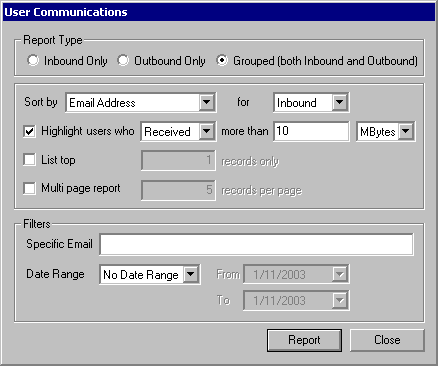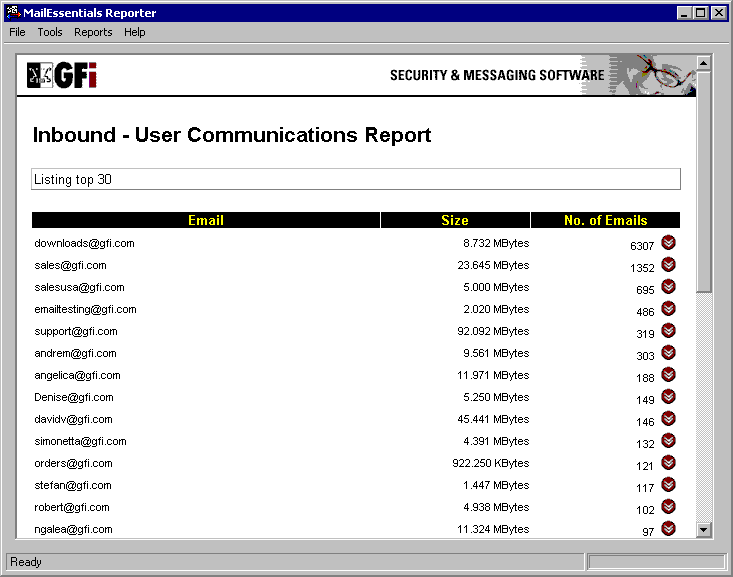Reports
While most email server
software packages provide basic logging functions relating to sent and received
messages, the log files that they provide are often cryptic and unmanageably
long. While a variety of third-party software packages can be used to parse and
display this data in different types of reports, this feature is already
included in GFI MailEssentials 8. The GFI MailEssentials Reporter tool provides
a wide variety of reports, including ones that display daily usage statistics
for individual users, domains, and the server itself. For example, the user
report displays information such as the total number of email messages sent by a
user, and their cumulative size. Furthermore, these reports can be tweaked and
tuned through the use of filters that allow you to view specific information
such as the amount of inbound or outbound mail sent by a user, dates, and the
number of messages retrieved.

For administrators, the
reports generated by GFI MailEssentials provide a simple way to not only manage
servers more effectively, but also provide management with a slick printout
that will certainly keep them happily occupied for hours.

POP3
Downloader
The last major feature of
GFI MailEssentials 8 is an integrated POP3 downloader utility. The main purpose
of this utility is to download messages from an external POP3 server (at your
ISP, for example) to your local Exchange Server. While this capability is not
usually necessary if you have a properly configured SMTP server on site with the
appropriate DNS MX record configured, some companies will still find this
feature useful. For example, companies using a dial-up Internet connection will
often not receive email to their internal SMTP or Exchange server in cases where
they dial into the Internet only intermittently. In this case, mail can be
stored on their ISP’s POP3 server, and then downloaded once a connection is
made. Once connected, mail can be downloaded and forwarded into a local mailbox
bearing the same name, or to a different specified local address. The POP3
downloader also allows you to specify a schedule at which the server should
connect to the Internet to download messages. Again, this feature is not for
everyone, but many companies will be thankful for a feature not natively
implemented in Microsoft Exchange.
Final
Thoughts
Having used the previous
version of GFI MailEssentials for well over a year, my feeling is that GFI has
put a great deal of time and effort into making version 8 a much more robust,
useful, and intelligent application. Not only does it do a superior job of
defeating spam compared to other products on the market, the additional features
like Mail Monitor, disclaimers, and the reporting capabilities combine to make
it an unbeatable value for any network that includes its own mail server.
However, there is still always room for improvement &emdash I would love to see GFI
include the ability to configure their products via a web interface (instead of
only via the MMC), if only to give administrators maximum flexibility. That
aside, this is one product that you simply cannot afford not to try. Given that
many of the core features are also provided in the freeware version, you simply
have nothing to lose. Use GFI MailEssentials for a week, and you might wonder what
you ever did without it.
Resources:
- More information about GFI MailEssentials 8 from GFI Software’s Web Site
- 60 Day evaluation version of GFI MailEssentials 8 from GFI Software

